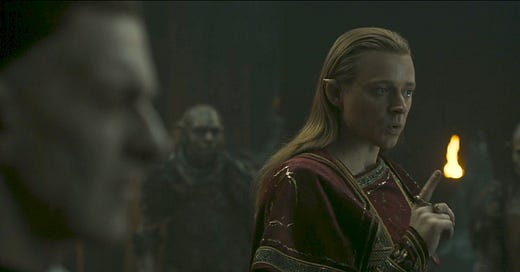How 'Rings of Power' S2 Retcons Sauron's Past and Future
The Dark Lord's portrayal has clearly evolved between seasons
Mae govannen, friends! Josh here. It’s the week of the season finale of The Rings of Power! Whether that makes you sad it’s already over, relieved it’ll be done soon, excited for the finale, or something else, I’ll have the final recap/analysis coming to you this Friday. Today I've got even more Rings Of Power content for you with a guest post from
from on Sauron’s shapeshifting as depicted in Rings of Power. It’s a good one: enjoy!Earlier this year, I wrote a long essay for Jokien with Tolkien about Rings of Power (ROP), where I theorized that, based on everything shown in Season 1 (S1), the series’ main antagonist Sauron had previously died at the hands of his former underling Adar before resurrecting in a diminished state as the human Halbrand. I also predicted that Season 2 (S2) would use flashbacks to fill in the gaps of Sauron’s S1 narrative.
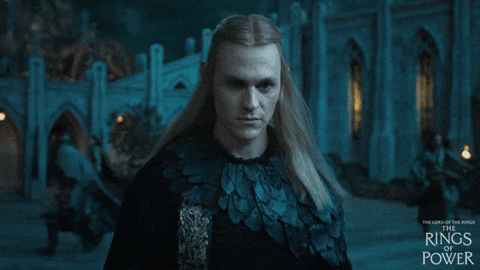
After S2 premiered a few weeks ago, I was happy to realize that my theory proved mostly correct. At the same time, I couldn’t help but be a little disappointed by evident retcons of Sauron’s story and the operating logic of his portrayal. In this article, I want to discuss how well my theory held up, illustrate how the series’ take on Sauron evolved, and speculate about this means for his future.
Table of ContentsSauron’s Original Form and Backstory
The New Timeline
The Annatar of it All
What About Rhun?
Conclusion
Sauron’s Original Form and Backstory
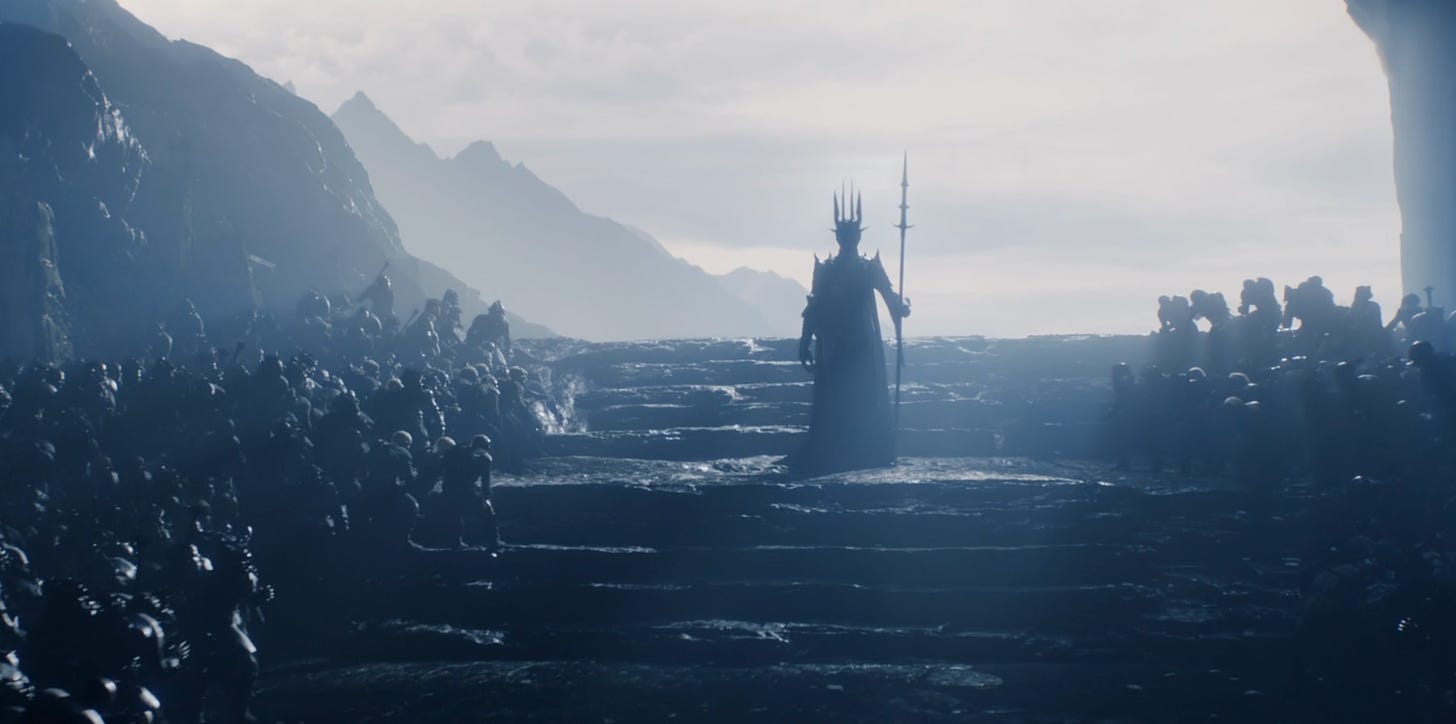
First and foremost, there are obvious discrepancies between what was established in S1 and what we see in the flashback sequence that opens S2 when it comes to Sauron’s backstory. In the opening prologue of S1, is is established that Sauron was the most loyal servant of the Dark Lord Morgoth and that under his command, Morgoth’s legions of Orcs had greatly multiplied and spread all over Middle-earth.
Now, it is not explicitly stated the Sauron came to rule the orcs after Morgoth’s defeat, but this is clearly the implication, for when Sauron first appears on-screen, he is depicted in what I like to term his “Armored Dark Lord” (ADL) form.
Here, it is worth reiterating what I stated in the previous essay:
“Here, Sauron appears as a tall humanoid figure clad head to toe in spiky black armor, much as he does in the prologue sequence of Jackson’s LOTR trilogy.
It is safe to assume that this is Sauron's Original or “True” form, given his description as a “Dark Lord” and the fact that this is Sauron’s first form in order of appearance. “
During her pursuit of Sauron over several centuries, as seen in 1.01, Galadriel finds the abandoned Northern fortress of Forodwaith, where there are multiple disfigured orc corpses, leading her to conclude that they “were meddling with the power of the unseen world. Some dark sorcery of old.” This is confirmed in 1.06 during Galadriel’s conversation with Adar, who reveals that Sauron led many orcs to follow him North after Morgoth’s fall, so he could craft a “power of the unseen world.”
Both the dialogue and cutaways to the various tools and corpses at Forodwaith make clear that Sauron had experimented on Orcs and ‘spilt blood’ in his attempt to craft this power. It is after sacrificing multiple children for Sauron that Adar turned against him and “split him open.”
However, in 2.01, which opens with a flashback to what happened at Forodwaith at the “dawn of the Second Age,” the (presumably) original form of Sauron is depicted as a fair-haired, normal-sized, Elvish-looking man played by Jack Lowden, a far cry from the imposing authority figure of the S1 prologue.
Not only is he physically 2.5 times smaller than the ADL incarnation, he also clearly has no control over the Orcs. Where an entire army of them bowed down or cowered in fear before ADL Sauron, the ones composing the relatively small group in the S2 prologue are brazen enough to publicly voice their doubts about Forodwaith Sauron’s leadership, with one going so far as to take a stab at him.

The visual storytelling of S1’s prologue thus clearly showed Sauron to be literally large and in charge, while that of S2’s prologue positions him as small and weak, a point underlined by how quickly the Orcs manage to overwhelm him once Adar kicks off his coup. The ensuing struggle shows that even though Forodwaith Sauron possesses superhuman strength and durability, he doesn’t really do anything to live up to the claim that he’s a powerful sorcerer able to manipulate the forces of nature.
“You fell from the stars, yet you are greater than they. You fell below the dust yet dust fears you. The winds and waters, the heat and cold. And every being that walks or crawls shall be your slave. For you are Lord Sauron.”
The Mystics describing Sauron in the S1 finale to the Stranger
One could arguably chalk this up to the Orcs being able to surprise Sauron and his not having much time to react in the heat of the moment, yet the differences between ADL and Forodwaith are so glaring as to call attention to themselves.
I’m certain I wasn’t the only one who wondered why Sauron here seemed so weak or when this flashback took place relative to the first time we saw him. Furthermore, I couldn’t help but notice that the manner and circumstances of Sauron’s death also seemed at odds with what was previously established.
Rather than depicting how Sauron’s obsession with the power of the unseen world gradually turned an initially loyal Adar and his children against him, the flashback instead shows that Sauron was betrayed on the day he was to be crowned as the new ‘Dark Lord,’ with the Orcs being disloyal from the very beginning.
Here, Sauron merely announces his plans to seek a new power and sacrifice orcs to achieve a new order in Middle-earth, but there’s no evidence that at this point he has carried any of them out, meaning the Orcs turn against him before he’s had a chance to perform experiments on them with dark sorcery. Finally, we see that contrary to his claim that he had split Sauron open, Adar merely stabs Sauron with the Dark Crown in the back before having his children finish him off.1
The New Timeline
What could’ve prompted all these shifts? It is difficult to say for certain.
After all, storytelling is an organic process that can be impacted by all sorts of factors. Sometimes, people just change their minds and come up with what they think is better for the story, while other times they adapt to external factors.2
I believe that at least some of the changes occurred due to the need to save on screen time. That is, the writers had only 20 minutes to reveal Sauron’s backstory and so chose to combine and compress various narrative events out of necessity. But whatever the reason is, the differences evince that the producers considerably revised their overall approach to Sauron and, with that, the show’s timeline.
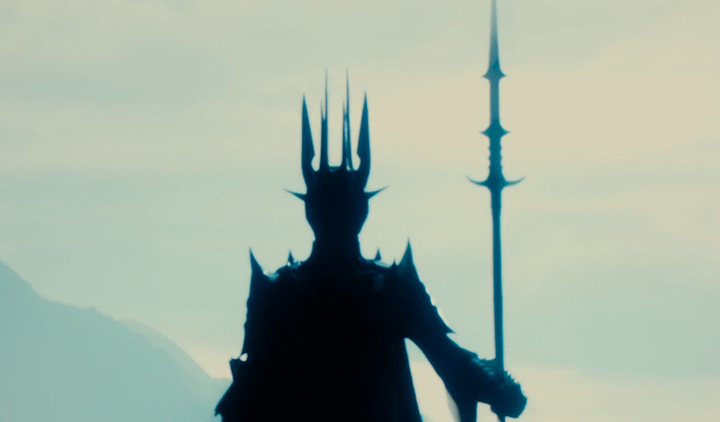
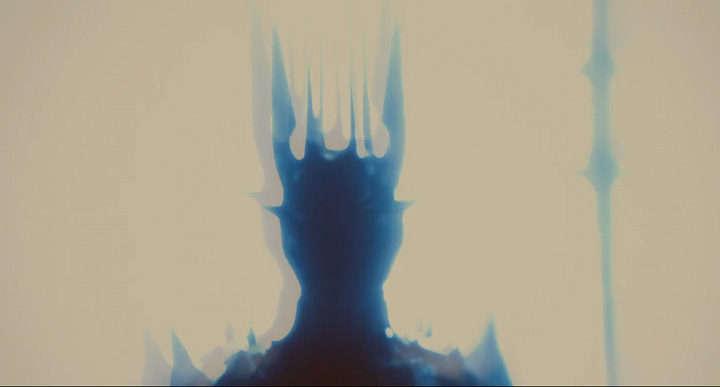
Everything we learn about Sauron throughout S1, alongside his depiction in the prologue, indicates that his ADL form was his earliest form, meaning he either had it from the outset or gained it before Adar overthrew him.
From this, it follows that Sauron had already become a Dark Lord and served as the Orcs’ master or commander for at least some time (presumably a few years) prior to physically dying and resurrecting in the fair human form of Halbrand.
By contrast, per S2, Sauron already had a fair yet not very powerful or intimidating form even before he resurrected as Halbrand. He had not yet become a Dark Lord and apparently was never really recognized as the Orcs’ master during the Second Age. Rather than a few years later, his death at the hands of Adar occurred shortly after Morgoth’s fall, as the Orcs immediately rejected his claim to power.
An obvious question then arises: if, as shown in S2, Sauron was deprived of the Dark Lord Crown before he could wear it for the first time, then why did we see him wear it with his signature armor in the S1 prologue, which was set before this?
My theory is that the brief appearance of ADL Sauron in the pilot’s prologue sequence is no longer set in the chronological past. That is, S2 has retroactively repositioned this as an event from the show’s future. This is corroborated by the fact that the Dark Crown re-appears in Galadriel’s vision of the future in 2.04, while Sauron’s ADL form appears in Gil-Galad’s vision in 2.05. Per the new timeline then, Sauron has not yet attained his ADL form. Rather, he will have gained it at some point later in the series, likely after getting officially crowned as the new Dark Lord.3
Assuming this is correct, I’d posit the producers have chosen to bring the plot of the series more in line with that of the source material, where Sauron only attains the “black and hideous” ADL shape after dying during the Drowning of Númenor. If so, then this all but assures that Sauron will indeed have perished during this event when it takes place on ROP (likely at the end of Season 4).
Of course, even if this is the intent of the producers now, they could always choose to go in a different direction. Case in point: Sauron’s new identity.
The Annatar of it All
In my previous essay, I pointed out that, because they had rights only to LOTR, The Hobbit, and the Appendices, the showrunners could not adapt elements of Sauron’s story that were exclusive to The Silmarillion, which included his ability to change form at will and his assuming the identity of “Annatar, the lord of gifts.” This is why, I argued, they created ‘Halbrand’ as a stand-in for Sauron’s “fair form.”
Initially, 2.01 seemed to confirm all this and so corroborated that in the adaptation Sauron could only change form in reaction to death and/or defeat. The very first line of dialogue we hear even reworks a crucial line from the LOTR books that outlined this internal logic in the novels:
“Always, after a defeat, the shadow takes another shape and grows again.”
But then, at the end of 2.02, Halbrand takes on a more heavenly, Elvish appearance (still played by Charlie Vickers) and announces to a stunned Celebrimbor that his name is ‘Annatar.’ In subsequent episodes, Sauron maintains this guise and is repeatedly referred to as ‘Annatar’ by different characters.
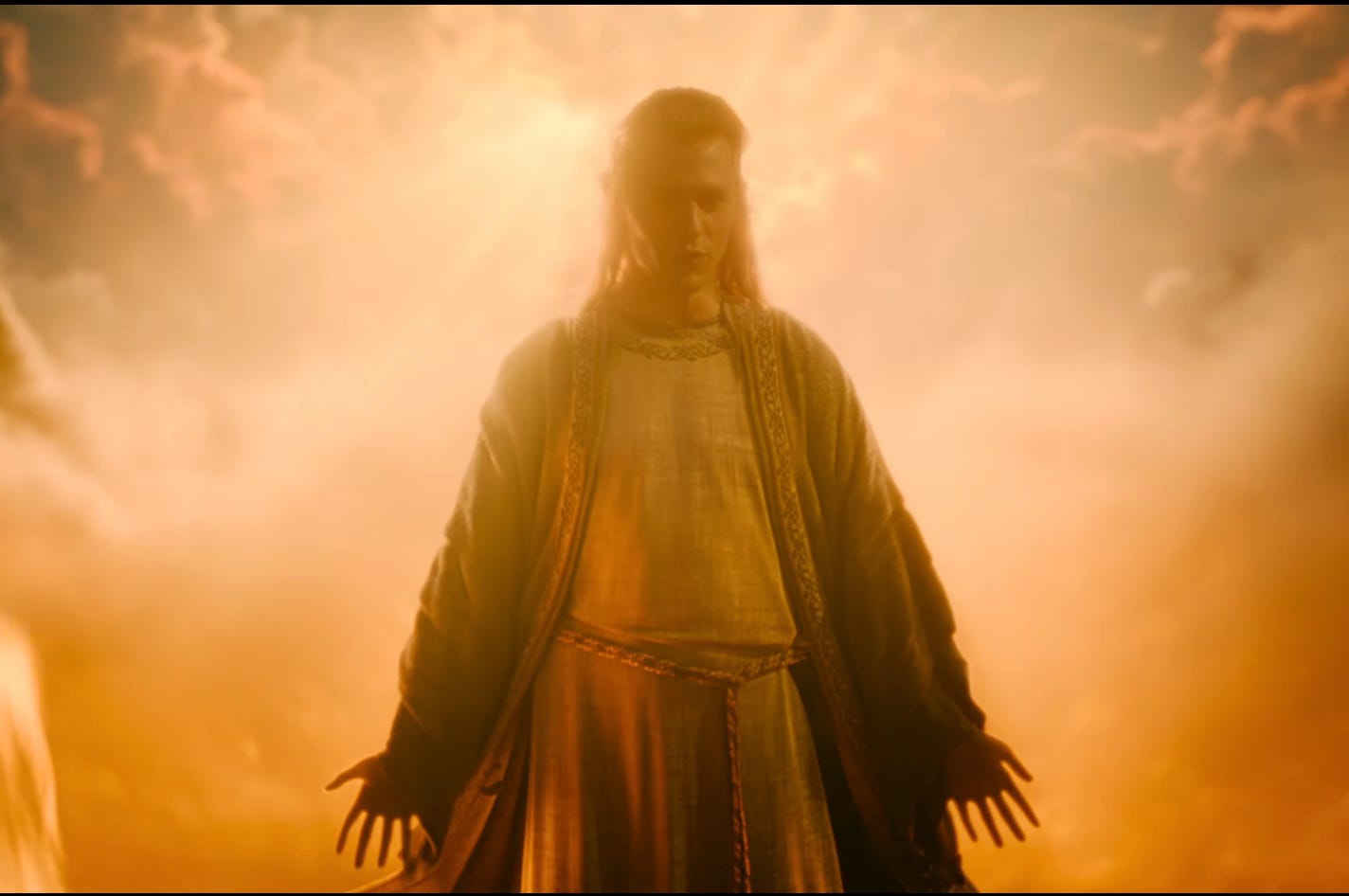
How to make sense of this, given the rights restrictions?
Though I haven’t found any interviews or articles that can definitively confirm it, I believe the simplest answer is that the producers gained permission from the Tolkien Estate to utilize select elements from The Silmarillion.4
That the Annatar name is clearly no longer off-limits means it’s also possible that Sauron’s shapeshifting has been expanded to allow him to change form at will.5
However, even assuming the writers now have legal permission to have Sauron do this, I am inclined to think that the show was and still is adhering to the logic that Sauron only truly changes form after dying. And this is because there are hints that Sauron’s ‘transformation’ into Annatar is not an act of shapeshifting at all.
Consider what we witness in Celebrimbor’s study: we don’t outright see Halbrand modify his features and turn into Annatar. Rather, he first vanishes and reappears only after showing Celebrimbor a series of illusions that convince him Halbrand is a messenger of the Valar, stepping out of the roaring fire, with a heavenly sky behind his back. We’ve seen Sauron in the S1 finale similarly get inside Galadriel’s mind and show her illusions of her brother, them being on the raft, etc.
But more than that, there’s a very telling conversation about 12.5 minutes into the episode between Galadriel and Gil-Galad, who states:
“It is said that once the Deceiver obtains a being’s trust, he gains the ability to sculpt their very thoughts. To deceive not only their heart and mind, but their eyes and ears. To alter their very reality.”
This precisely describes what we see Sauron do at the end of the episode.
He first approaches Celebrimbor in his familiar human guise, convinces him that he’s a friend, and only then does he appear before him in his so-called ‘natural form.’ This implies Sauron didn’t physically transform but rather altered Celebrimbor’s perception of reality, making him see Halbrand differently.
In this sense, Annatar is an illusory modulation of the Halbrand form rather than a new form entirely, possibly explaining in-universe why he’s also played by Charlie Vickers. Supporting this conclusion is a recent interview with Director Charlotte Brändström, who stated the following about the premiere episodes:
“Celebrimbor believes all the time he has the upper hand. He’s being tricked, and Sauron gets into his head. He has him imagine things, and controls him all the time.”
*Source: Jordan Moreau, Variety, August 29, 2024
What all this tells me is that even though the producers can use Sauron’s Annatar identity now, they either cannot or will not have him be a full-on shapeshifter.
One can infer that, due to rights restrictions, the showrunners initially designed Sauron’s story so it could work without Annatar. Then, having gained permission to use Annatar, they had to modify their original S2 plans and come up with a way to alter Sauron’s appearance without having him actually change form.
What about Rhûn?
The biggest difference between the backstory I outlined for Sauron in my article and what ended up on screen in S2 has to do with how exactly Sauron resurrected following his physical death and where he chose to go afterwards.
When Forodwaith Sauron ‘dies,’ his physical body explodes and releases a beam of light into the sky, causing a massive shockwave that freezes over parts of Forodwaith and triggers snowfall in the surrounding areas. This appears to tie into the idea that Sauron originally “fell from the sky,” as stated by the Mystics.
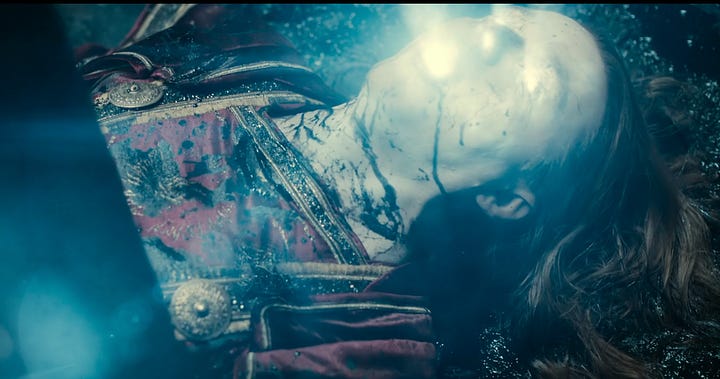
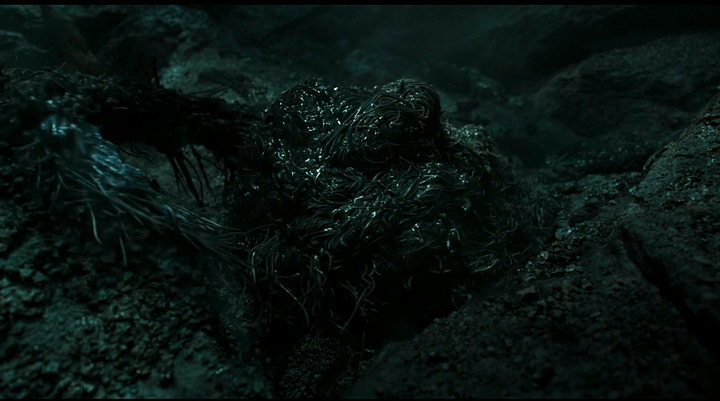
However, rather than return to the sky as an incorporeal spirit before crashing back down as a meteorite, Sauron instead turns into a black liquid and spends countless years dormant at the bottom of a mountain.6 Calling to mind Marvel Comics’ symbiotes and blob-like alien creatures from horror movies, Sauron’s liquid form eventually begins consuming nearby living creatures like rats and centipedes, gaining enough strength to crawl out of the mountain. It then consumes a human passerby and so takes on the now familiar physical form of Halbrand.
I have no idea if this take on Sauron’s rebirth is what the writers had always planned when they made S1, but I like it, as it fits quite well with the events of S1, never expli-citly contradicting anything established previously.
That said, it raises a lot of new questions, especially in regard to how Sauron’s story ties into that of the Stranger. If Sauron resurrects by turning into a liquid state and then rebuilding his physical body, then why were multiple individuals in S1 convinced that the meteorite was a sign of his return?
How could the Mystics, who were Sauron loyalists, know that he’d resurrect, yet not know the manner in which he’d actually come back to life? How did they discover that he had died in the first place? And why didn’t Halbrand make any attempt to go to Rhûn, where the Mystics were ready to help and serve him?
After all, everything we’ve seen so far keeps pointing to the idea that Sauron has been to Rhûn before. He clearly became known to the Mystics before his death, which means he must’ve been there during the First Age.
“I have walked through the dust and the deserts of far-away lands…”
Sauron to Celebrimbor
I’m really hoping that the writers make sense of most if not all this before the season is over, as the opening flashback of S2 did nothing to clarify the significance of Rhûn and the Stranger’s present-day narrative to Sauron’s backstory. As a result, the wizard’s storyline still feels heavily disconnected from everything else.
Conclusion
Overall, it seems that while the writers have stuck to the core idea of Sauron’s back-story that was underlying S1, they have reconceived certain aspects of the character and his arc. S1 Sauron apparently began the Second Age as a powerful and fearsome Dark Lord, only to fall and hit rock bottom. Now in a crippled state, he sought a way to regain his lost power and status.
S2 Sauron, by contrast, began the Second Age as a weak and entitled pretender to the throne. His fall didn’t really diminish him as he was never all that powerful to begin with. Consequently, he seeks to ascend to a higher level of power than he ever had before and truly become the new Dark Lord.
On principle, I have nothing against the new approach, which is arguably more in line with the source material, but I think I would’ve preferred the former, as Sauron had much more to lose and gain. Not to mention, it would’ve made for a stronger sense of continuity and consistency between S1 and S2.
Going forward then, I hope the producers avoid further retconning Sauron. Or if they do, I hope they do so in a manner that feels more seamless and imperceptible.
But what do you think?Has the show’s approach to Sauron and his backstory indeed radically changed between seasons? Can Sauron truly shapeshift now as he sees fit?
Has the timeline of events been revised so that he becomes the Armored Dark Lord in the future or is there some other explanation?
Was it always the plan in S1 to have Sauron spend some time as a Black Liquid?
And how will the Rhûn subplot actually tie into his story now? Please,
Sauron kills multiple orcs during his Ides of March-like assassination, which could explain those corpses Galadriel found, but that still doesn’t really fit what we saw in S1.
Indeed, S2 ended up recasting Adar and dropping the character of Bronwyn entirely due to the departures of their respective actors.
I wouldn’t be surprised if at least the crowning will have occurred in the second season finale, mirroring the opening flashback scene.
Giving credence to this is the fact that the writers of ROP submit scripts and outlines to the Tolkien Estate for feedback and approval, as well as consult with Tolkien experts to ensure they do not go too far outside the lines of the Legendarium (and likely don’t do anything to break copyright). J.D. Payne described this process in an interview that can be seen here. As he explains, certain changes or deviations from the source material are agreed upon beforehand, while others - on a case-by-case basis. It is likely then that Silmarillion elements are agreed upon in a similar manner. Tellingly, the opening credits of the S2 episodes still state the show is based on ““Lord of the Rings” and Appendices.”
David Goyer had a similar issue when adapting Asimov’s Foundation books into the Apple TV+ series. Though he could use the character Eto Demerzel, he could not include Demerzel’s true identity ‘R. Daneel Olivaw’ due to not having the rights to I, Robot, where the character Olivaw originated. However, Goyer then appealed to the head of FOX and was given permission to utilize the Olivaw name in certain instances on the show.


